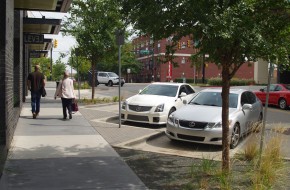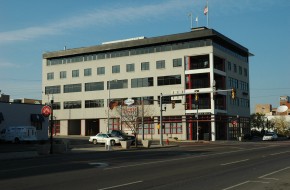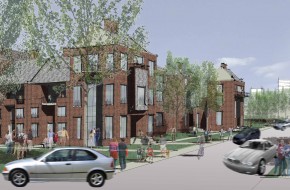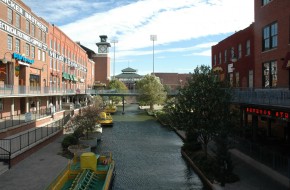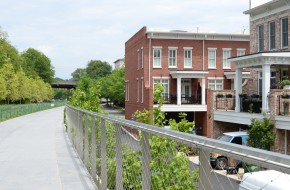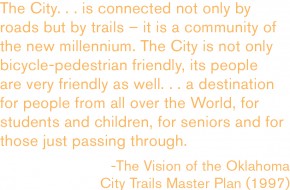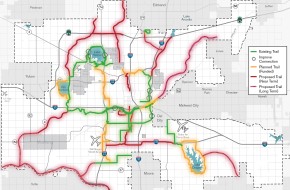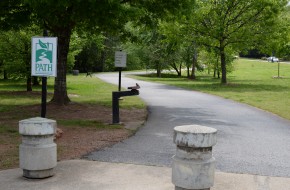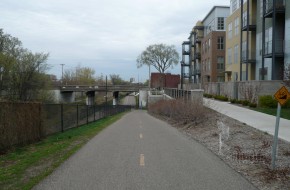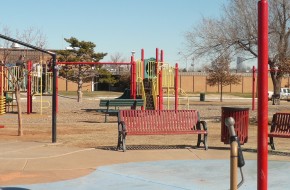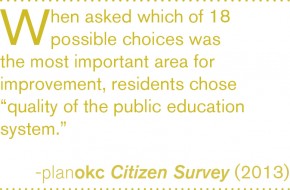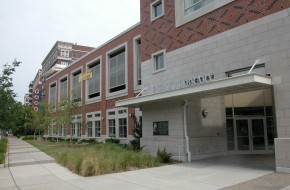The initiatives below relate to education. Click on any initiative to view a full explanation and related policies.
We will provide incentives and investments that produce a favorable environment for private investment on underutilized sites. In Oklahoma City, we have tended to view land as an inexhaustible and disposable resource, reducing the desirability of older areas and decreasing land values, while expanding the city's boundaries outward. The surveys and process of planokc show that this view is also changing, as citizens place a high value on using existing infrastructure and urban land effectively and rebuilding established neighborhoods. Preferences are also changing, as many families appreciate active urban places like Midtown and Automobile Alley that provide living, shopping, entertainment, and work places with good walking, bike, and transit access. Effective use of existing land resources is a central principle of Chapter Two's land use vision.
Redevelopment and infill depend on major private investment. City policy and action can create the conditions that help this private investment occur.
Directions for these policies include:
- Site assembly. Multiple property owners, often absent or very difficult to find, can make it impossible to put together sites for redevelopment. The City can help private developers by helping them assemble sites.
- Infrastructure and street improvement. While redevelopment and infill sites usually have infrastructure, these facilities are sometime obsolete and require improvement. Redevelopment can provide the impetus for making necessary public investments in these assets.
- Public investments. Parks, schools, civic facilities, pedestrian and bicycle facilities, streetscapes, and other amenities can provide anchors that are proven to generate private development. The Bricktown Canal is an excellent example of a public amenity that has paid for itself many times over in private investment. Similarly, the new MAPS 3 Park will inevitably become the catalyst for the Core to Shore redevelopment.
- Code improvement and proactive enforcement. Poor property maintenance, unattractive and cluttered signs, and public or operating nuisances can degrade the value of surrounding property and discourage reinvestment. Updated ordinances and consistent, enforcement will minimize these disincentives and create momentum for new private development.
Click to expand policy information.
Establish new incentives and raise awareness of existing incentives that stimulate the preservation and rehabilitation of historic resources. Incentives could include:
- Preservation easements, low-interest or forgivable rehabilitation loans, and Tax Increment Financing Districts for historic buildings, sites, and districts.
- Tools and practices for public/private partnerships to ensure the preservation and retention of top-priority historic resources whose deterioration or demolition would present an irreparable and highly significant loss to the City and beyond.
- Existing city, state, and federal tools and incentives for rehabilitation, including state and federal tax credits for certified rehabilitation.
- Expedited review process for projects involving infill sites.
Support and incentivize the adaptive use of existing buildings, infill development, and brownfield development.
Modify codes and/or regulations to create opportunities for more income diversity and mixed-income neighborhoods by allowing a variety of housing ownership and leasing arrangements, diverse housing sizes and types – including accessory dwelling units, carriage homes, lofts, live-work spaces, cottages, and manufactured/modular housing. Modifications should allow an increase the variety of ownership opportunities to include condominiums, ownership cooperatives (such as mutual housing associations, limited equity cooperatives, etc.) by identifying and removing regulatory barriers. Recommend improvements to protections for owners, developers, and lenders.
Priority should be given to projects that achieve efficiencies described elsewhere in planokc, such as dwelling units that are located to have easy access to each other and to other daily needs including jobs, recreation, and schools.
Maximize the use of all appropriate state, federal, local, and private funding for the development, preservation, and rehabilitation of housing affordable to a variety of income groups, including those that integrate low-income housing units in otherwise market-rate housing developments and support the creation and/or expansion of mixed-income communities.
Integrate housing rehabilitation programs with neighborhood revitalization programs. These programs should include assistance to property owners to renovate the existing housing stock with improvements that reduce utility and maintenance costs for owners and occupants, conserve energy, conserve water, and reduce greenhouse gas emissions.
Establish new or expand existing financing methods and/or mechanisms available to new and redevelopment mixed-income projects in urban areas. These could include: direct investment of public housing funds, tax-increment financing, bonds, revolving loans, housing program funds and/or other proven public-private partnership models.
Create and/or enhance Community Development Corporations (CDCs) and Community Housing Development Organizations (CHDOs) to increase their capacity to provide mixed-income housing, especially in targeted infill areas.
Reuse brownfield, greyfield, and other vacant building sites to provide new opportunities for mixed-used and mixed-income housing.
Prevent concentration of low-income populations by providing housing opportunities for all income groups in targeted redevelopment areas of the city with a particular focus on mixed-income projects, especially on those projects that have a public funding component.
In conjunction with City regulatory changes, such as significant modifications to zoning ordinances, building codes, or subdivision regulations, assess the effects of the proposed modifications on housing development costs and overall housing affordability, considering the balance between housing affordability and other objectives such as environmental quality, urban design quality, maintenance of neighborhood character and protection of public health, safety and welfare. This assessment should be integrated into the code amendment process, identify barriers to housing affordability, and include recommended mitigation.
Add legislative priorities for state laws to:
- Strengthen the City’s ability to obtain specific performance of property owners cited for code violations.
- Speed up the demolition process for long-time boarded properties that cannot be rehabilitated.
- Strengthen the City’s ability to require property owners to rehabilitate or sell neglected, boarded-up properties.
- Expedite the clearing of properties involved in probate.
Strategically use subsidized housing programs along with other City services and programs to revitalize targeted areas of the city.
Support infill development on vacant, underutilized, and brownfield sites by:
- Allowing densities sufficient to incentivize infill in older areas
- Focusing resources on target neighborhoods to build positive momentum
- Evaluating and adjusting zoning in areas where infill is desired
- Reducing permit fees and processing time for infill development proposals
- Waiving the requirement for traffic impact analyses for infill development proposals
- Establishing an Abandoned Buildings Program and enhancing it over time by:
- Seeking changes in City ordinance and State statute where necessary to allow for cost recovery of police and fire services costs caused by vacant buildings
- Using revenue collected beyond Vacant and Abandoned Buildings program administration cost for neighborhood improvements
- Submitting land bank legislation to the State Legislature and establishing a land bank authorized to acquire, rehabilitate, and dispose of abandoned properties
- Offering temporary or short term catalyzing incentives for the first “infillers” in target neighborhoods. Incentives may include small grants and/or low interest loans from a revolving loan fund or for property improvements.
- Evaluating the possibility of basing property taxes on only land value and not improvements, thereby encouraging high intensity use of well-positioned land and discouraging underutilization and long–term vacancy.
Mitigate negative impacts of compactness by:
- Updating nuisance code to better address noise, smell, vibration, property maintenance, panhandling, animal control, delivery hours limits, and other possible negative effects.
- Updating the sign ordinance to reduce visual clutter.
Prioritize and concentrate development where facilities, infrastructure, and services have capacity and in areas where the Police and Fire Departments are best able to respond. Guide the location and timing of development through the proactive and strategic installation of infrastructure.
Create and implement small area plans for neighborhoods or districts with special strategic importance or complications related to development or redevelopment.
Identify priority areas where the City can maximize private investment by providing public infrastructure and amenities including:
- Transit;
- Parks, trails, sidewalks;
- Streets;
- Arts and cultural facilities.
Encourage redevelopment and infill development on vacant, underutilized, and brownfield sites in urbanized areas.
Catalyze infill development on vacant, underutilized, and brownfield sites in urbanized areas by:
- Investing in infrastructure improvements;
- Improving multi-modal transportation networks;
- Improving parks and open spaces;
- Improving schools and other civic resources;
- Exploring innovative methods such as:
- A public-private partnership to purchase problem properties in target areas and build or rehabilitate homes while improving infrastructure and amenities
- An infill house plan program similar to Sacramento or Milwaukee
- Identifying and removing barriers to rehabilitation and/or replacement of residential buildings.
- Establishing a position in the City to facilitate medium- and large-scale redevelopment projects through the development process by guiding interactions with City departments, allied agencies, and utility companies.
Encourage the adaptive reuse of underutilized structures and the revitalization of older, economically distressed neighborhoods.
We will design and implement a bicycle route system based on getting people to priority destinations. The current Bicycle Transportation Plan provides a two-phased network of potential bike routes. This network is based on evaluating various streets for bicycle suitability, and provides a solid foundation for implementation. The system should now be refined by considering destinations and designing routes that assemble on-street segments and trails into an entire network that serves multiple destinations.
We will incorporate appropriate support features such as bike parking and wayfinding signage into the system. On and off-street facilities function best with relatively inexpensive support facilities like parking and information graphics. Zoning ordinances and cost-sharing programs can both require, and encourage through incentives, bike parking for appropriate land uses, like major commercial, multi-family, and mixed use development. Desirable city actions include installing bike parking in public parking structures and business districts and encouraging bike "corrals" in which one parking space is dedicated to bike parking in neighborhood business districts.
Click to expand policy information.
Identify areas that could be used to establish a greenbelt network throughout the City that connect major employment centers, commercial sites, parks, and key locations within major residential neighborhoods. Use the greenbelt as the backbone for a bicycle trails network which all other bicycle trails feed into.
Create and implement a citywide bicycle and pedestrian master plan that addresses riders of all levels.
Require the placement of secure, properly positioned bicycle parking within multi-family and commercial development, and in all public parking garages.
We will design or retrofit trails to provide convenient and barrier-free access to adjacent streets and major destinations. A trail that provides miles but does not connect to its surroundings may provide benefits to people seeking workouts, but it fails in its transportation mission to move people to places. In addition, poor access or visibility to and from surroundings can create public safety problems as well. We must design new trails and retrofit existing trails to provide frequent and comfortable access to wayside destinations and streets, with clear signage that helps orient users to their location.
Click to expand policy information.
Create a standards for trails based on industry standards, “Crime Prevention Through Environmental Design” principles, expected use, and surrounding land uses.
Acquire easements in new and existing developments to develop and connect trails.
Establish connections between parks, residential areas, and other points of interest by constructing additional bike routes, trails and pedestrian paths to meet the growing demands for recreation and alternative transportation routes.
Require that new development tie into the park and trail system by providing linkages to existing parks or dedicating new park land. Connect existing parks and neighborhoods to create a continuous system of open spaces, for example along stream corridors.
We will develop and implement a strategic plan for the city's pedestrian network, building on the foundation of the 2013 Sidewalk Master Plan for MAPS 3. The 2013 Sidewalk Master Plan was a significant step forward, including an analysis of pedestrian demand in different parts of the city. However, its primary purpose was to identify priority projects for a specific sidewalk construction category of MAPS 3. Many of these projects supply new sidewalks along major corridors with high demand, based on a systematic rating system. These are extremely important, but many other problems remain, including:
- Neighborhood sidewalks on local streets that provide access to destinations such as schools and transit stops.
- Barriers to pedestrian travel such as major intersections, long arterial street crossings, and signal timing.
- Relationship of sidewalks to other parts of the active transportation network, including multi-modal streets, bicycle facilities, transit, connections to adjacent development, and trail access.
These issues require an expanded pedestrian system plan that:
- Identifies a Complete Streets Network prioritizing pedestrian corridors that should be developed and funded as part of the city's transportation program. The MAPS 3 and previous bond issue study provide a starting point for this network.
- Establishes standards for local sidewalk coverage and a process to evaluate pedestrian service on a neighborhood by neighborhood basis. An example of such a standard would be provision of a complete and well-maintained web of sidewalks within a 1/2 mile walking radius of elementary and middle schools.
- Identifies key pedestrian barriers that obstruct access for important user groups, including children and older adults. This effort should include standards and techniques to minimize these barriers.
- Relates other active modes or facilities to the sidewalk network.
- Provides a phased implementation program that may include individual categories of funding, such as neighborhood target areas and major network investments.
Click to expand policy information.
Enhance the safety and walkability of the sidewalk network through:
- Establishing a citywide bicycle and pedestrian master plan that includes an inventory of sidewalk locations and conditions, and priorities for enhancement.
- Implementing sidewalk improvements through future bond issues, CIP projects or other sources of funding as prioritized in the citywide bicycle and pedestrian master plan.
- Maintaining currency of the citywide bicycle and pedestrian master plan.
- Explore the feasibility of the City assuming responsibility for sidewalk maintenance.
Establish requirements for providing alternate pedestrian routes when construction activity prohibits use of existing facilities.
We will establish partnerships between the City and school districts to assist in non-educational functions. School districts deal with a variety of non-educational or indirectly educational functions on a regular basis. This includes siting of new schools, redeveloping closed schools, addressing crime and crime prevention, and other community outreach functions. By working together, funding should be leveraged and resources used efficiently to strengthen neighborhoods, making them viable choices for young households.
We will co-locate new public projects in coordination with local school districts. Strong civic institutions strengthen neighborhood identify, social interaction and appeal to investors. Co-locating public projects such as libraries, fire stations, parks, recreation centers, and schools create neighborhood activity centers and realize efficiencies through joint use arrangements.
Click to expand policy information.
Establish a working partnership between the City, Oklahoma City Public Schools, Putnam City Schools, Western Heights Schools, and other metro area school districts and educational entities to help school districts complete a variety of non-educational (or indirectly educational) functions such as planning for and siting new schools, working on shared use issues, and redeveloping closed schools. The partnership should coordinate efforts to seek funding and appropriate resources to accomplish the following:
- Establish multiuse recreational and exercise facilities in schoolyards to increase opportunities for physical activity and strengthen the relationship between schools and neighborhoods.
- Establish a program to increase the number of community members and schools that make effective use of Senate Bill 1882 (effective 11/1/2012) allowing shared use of school facilities for recreational purposes.
Support diverse and high-achieving student bodies through the creation of mixed-income neighborhoods that encourage parental and community involvement by:
- Integrating home sizes and types at neighborhood and block scales,
- Avoiding concentrations of low-income households by encouraging income diversity within neighborhoods and by spending City housing funds in a manner that does not concentrate low income households in one development or neighborhood, but instead creates opportunities for these households to live in income-diverse neighborhoods, and
- Encouraging school districts to open schools and school grounds after school hours to support community engagement and more convenient opportunities for active recreation.
We will support our schools in improving student performance. Low academic performance is a problem in our city, and especially within Oklahoma City Public Schools, as measured by the State Department of Education. Our entire community must address this issue aggressively. Some solutions involve long-term and continuing efforts, such as creating and sustaining healthy, mixed-income neighborhoods that provide the secure environments necessary to nurture learning and achievement. Recommendations that help create these types of neighborhoods are found throughout planokc, from land use initiatives to neighborhood reinvestment and housing variety. Other specific efforts, involving concerted action by the public and private sectors and school districts can provide more immediate results. These educational support programs can include scholarship programs that offer post-secondary grants to students in inner-city schools and districts, expanded early childhood education, after- school programs, mentoring, specialized educational tracks, teacher skills training, or financial incentives for high-performing schools and teachers.
The City will also assist the Greater Oklahoma City Chamber of Commerce in efforts to adapt the education and training offered by local institutions to match the current and future needs of local companies. This includes both K-12 schools and secondary schools.
Educational issues and programs represent a convergence of different perspectives. This element approaches good educational programming from a workforce and economic development framework; liveokc from a neighborhood development viewpoint; and serveokc from a public service and community quality point of view. However, all point in the same direction, highlighting the importance of increasing achievement and learning.
Click to expand policy information.
Facilitate communication among the 23 school districts in order to develop more arts education opportunities for the children in our community.
Establish development standards and design guidelines for new cultural, civic, and sporting facilities that address site design, architecture, compatibility, pedestrian-orientation and access, landscaping, and the inclusion of public art.
Create partnerships and programs involving civic groups, business organizations, governmental entities, coalitions, and non-profits to develop or enhance the following:
- School reading programs;
- Elementary school intramural sports leagues;
- Rehabilitation of school infrastructure and replacement of school equipment (athletic facilities, media center materials, computers, etc.);
- After-school programs that focus on mentoring or conflict resolution;
- Rehabilitation of City parks;
- Community involvement opportunities associated with public schools; and,
- Other projects or programs that improve neighborhood safety by working with children.
Coordinate with Strong Neighborhoods Initiative to provide recreational, fire safety, public safety, and character building programs in schools.
Identify ways to establish/strengthen relationships and partnerships between schools and the business community as one method to improve student education and outcomes.
Support diverse and high-achieving student bodies through the creation of mixed-income neighborhoods that encourage parental and community involvement by:
- Integrating home sizes and types at neighborhood and block scales,
- Avoiding concentrations of low-income households by encouraging income diversity within neighborhoods and by spending City housing funds in a manner that does not concentrate low income households in one development or neighborhood, but instead creates opportunities for these households to live in income-diverse neighborhoods, and
- Encouraging school districts to open schools and school grounds after school hours to support community engagement and more convenient opportunities for active recreation.
Work with the Greater Oklahoma City Chamber of Commerce to recommend adaptations to local education and training opportunities to match the current and projected needs of local companies.
Develop methods for the City to aid school districts in bolstering student performance. Explore the following methods:
- A cooperative City and business-funded scholarship program for OKC residents in underperforming school districts following the same pattern as The Pittsburgh Promise, which offers post-secondary scholarships to academically qualified students who live in Pittsburgh and attend Pittsburgh public schools,
- Increased police presence for security and truancy prevention,
- City-funded after school facilities and programs,
- City-funded financial rewards to schools showing measurable improvement,
- City-funded financial or other rewards to high-performing teachers,
- City-funded teaching skills training.
Encourage redevelopment and infill development on vacant, underutilized, and brownfield sites in urbanized areas.
Catalyze infill development on vacant, underutilized, and brownfield sites in urbanized areas by:
- Investing in infrastructure improvements;
- Improving multi-modal transportation networks;
- Improving parks and open spaces;
- Improving schools and other civic resources;
- Exploring innovative methods such as:
- A public-private partnership to purchase problem properties in target areas and build or rehabilitate homes while improving infrastructure and amenities
- An infill house plan program similar to Sacramento or Milwaukee
- Identifying and removing barriers to rehabilitation and/or replacement of residential buildings.
- Establishing a position in the City to facilitate medium- and large-scale redevelopment projects through the development process by guiding interactions with City departments, allied agencies, and utility companies.
Encourage the adaptive reuse of underutilized structures and the revitalization of older, economically distressed neighborhoods.
Support diversity and integration of housing unit types and sizes in all land use typology areas in order to meet the diverse needs of households of different sizes, generational needs, incomes, and preferences. New residential subdivisions should achieve a mixture of housing types within a unified development.
Avoid concentrations of apartment complexes. Instead, integrate multifamily units into neighborhoods with mixes of housing types or in mixed-use developments.
Amend the zoning ordinance to better accommodate the integration of various residential densities, building types, and styles.
We will coordinate library service planning with investments in City facilities and neighborhood planning. Oklahoma City should partner with the Metropolitan Library System and the State Department of Libraries to coordinate facility expansions, improvements, and new facility locations with other types of civic investments, such as schools, fire stations, and parks. This could allow for efficiencies through facility sharing or co-location.
New and remodeled libraries should support neighborhood planning goals by integrating themselves into their surroundings. The City should adopt design standards for both new and remodeled libraries that focus on integrating the building and site into the surrounding neighborhoods, thus increasing access to the libraries by walking, biking, and transit.
Click to expand policy information.
Form a working partnership with the library system, both the Metropolitan Library System and the Oklahoma Department of Libraries, to coordinate timing of facility expansions, improvements, and new facility siting with other types of civic resources, such as schools, fire stations, parks, and projected growth and demand for those resources. This should also include identifying a mechanism to provide library services in Canadian County.
Adopt design standards applicable to both new and remodeled libraries focusing on integrating the building and the site into existing neighborhoods and urban fabric, reducing their dependence on automobiles and increasing their access by other modes, especially walking, biking, and transit.
We will form partnerships and implement efforts that create settings that advance educational achievement. The challenges facing Oklahoma City's public education system are daunting. The stakes of success are great, given the need to capitalize on the potential of our youth and the importance of quality schools in achieving this plan's overall goals. School policy and curriculum are far beyond the scope of planokc. But City policy can help provide safe and nurturing environments that remove at least some of the pressures and distractions that keep kids from learning. Both this element and liveokc address people's expectation to live in safe neighborhoods.
The City's Strong Neighborhoods Initiative (SNI) program, for example, can establish recreational, fire safety, public safety, and character building programs for schools. This program to create supportive environments includes initiatives discussed in previous elements – parks and recreational programs, neighborhood development, stabilizing social fabric, and many others. Direct partnerships with schools can also be extremely effective. The City can initiate strong connections between schools and the business community to improve education, training, and retraining. Finally, a city that includes 27 school districts and has helped fund projects in many of them can help initiate regional cooperation and some sharing of responsibilities.
Click to expand policy information.
Facilitate communication among the 23 school districts in order to develop more arts education opportunities for the children in our community.
Incorporate preventive health care and wellness education into public schools, recreation centers, senior centers, and technical/trade schools.
Establish a working partnership between the City, Oklahoma City Public Schools, Putnam City Schools, Western Heights Schools, and other metro area school districts and educational entities to help school districts complete a variety of non-educational (or indirectly educational) functions such as planning for and siting new schools, working on shared use issues, and redeveloping closed schools. The partnership should coordinate efforts to seek funding and appropriate resources to accomplish the following:
- Establish multiuse recreational and exercise facilities in schoolyards to increase opportunities for physical activity and strengthen the relationship between schools and neighborhoods.
- Establish a program to increase the number of community members and schools that make effective use of Senate Bill 1882 (effective 11/1/2012) allowing shared use of school facilities for recreational purposes.
Coordinate with Strong Neighborhoods Initiative to provide recreational, fire safety, public safety, and character building programs in schools.
Identify ways to establish/strengthen relationships and partnerships between schools and the business community as one method to improve student education and outcomes.
Support diverse and high-achieving student bodies through the creation of mixed-income neighborhoods that encourage parental and community involvement by:
- Integrating home sizes and types at neighborhood and block scales,
- Avoiding concentrations of low-income households by encouraging income diversity within neighborhoods and by spending City housing funds in a manner that does not concentrate low income households in one development or neighborhood, but instead creates opportunities for these households to live in income-diverse neighborhoods, and
- Encouraging school districts to open schools and school grounds after school hours to support community engagement and more convenient opportunities for active recreation.
























